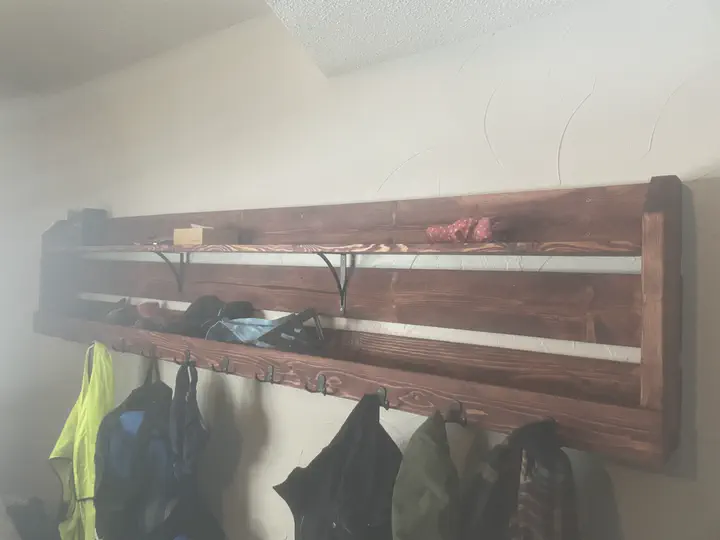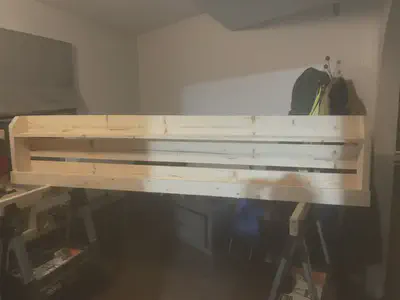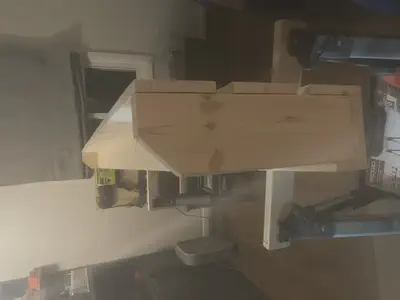Mudroom Coatrack

In this project, I followed the general design from here, expanding the size of the coatrack so that it extended along most of the space in one side of the mudroom. Now, instead of only 5-6 coat hooks are scrunched together and no cubby/shelf storage for hats/mittens/etc, we have 24 coat hooks and copious amounts of cubby/shelf storage!
Pictures
 |  |
| In progress, everything sanded by not stained. You can see the tiny old coatrack on the wall in the background. | Same as left, but different angle. |
Lessons Learned
Materials
When you go to a lumberyard at a place like Menards and get a board out of the 8’ section, take a measuring tape and make sure it is actually 8’. The 2x6 board I chose for the bottom of the coatrack was ~2.5" short, so I ended up having to modify my design to accomodate that. Not a showstopper, but still irritating.
When you go to a lumberyard, check all of the boards you choose for structural cracks, bowedness–don’t just assume that all of the boards are “good”. FWIW, Menard’s seems to have MUCH better lumber than either Home Depot or Lowe’s, and least near me. I didn’t do this for the coatrack, and ended up with some boards which were noticeably bowed. I was able to mostly–but not entirely–work around this with clamping as I went along, so the file product was not quite as true as I would have liked. Even so, unless you know where the bowedness is, it’s not so bad imo that your eye is drawn to it.
Building
Check for square at each and every step, because it is easier to correct it on the piece you just added than when you get 90% of the way done and realize some aspect of the project is just not square enough to be a problem. This happened with one of the vertical end pieces.
When joining boards in a “T”; that is, drilling through the face of board #1 into the edge of board #2 for e.g., a shelf, mark the exact thickness of board #2 on both faces of board #1 where it is supposed to goa. This ensures that:
You clamp the board exactly in the desired position so that after adding screws and removing clamps the board ends up where you intended.
When drilling into board #2, you don’t drill too close to the surface of it. If board #2 is for e.g., a shelf, then this can result in the screw beginning to split the wood as weight is applied to the shelf as you put stuff on it.
Both of these happened with the upper shelf of the coatrack, and I had to re-clamp and and some more screws to try and get the board into the correct position, which was made more difficult because the shelf board I had bought was bowed into a subtle “smile” as you sighted down the length of the board.
When trying to get large projects square, if you need to clamp something larger than the biggest clamp you have, tow straps work GREAT! I discovered this by accident on the Garaga Shelves project, and it was invaluable to try to square this project as well.
Staining
You can’t trust that the samples they have at the hardware store showing how a stain will look on this wood or that are accurate–who knows how long they’ve been sitting there!
You also can’t trust the color they show on the can, because that’s just marketing, and is probably an artificially created image–not a picture of that particular stain actually being applied to anything.
The only thing you can trust is doing what the instructions on the can say: test a little of the stain on a small inconspicuous area, let dry, and see what you think. I did NOT do this for the coat rack, and stain the whole thing “Caberet”, which as you might imagine, turned out rather, well, caberet-esque–a nice PURPLE wine color.
In the store, the Caberet color looked a nice deep reddish-brown, which was what was on the can too. Needless to say, after the initial staining, both my wife and I agreed that the color was awful, and so I had to spend like 5 hours with the sander removing it before staining it a more reasonable color.